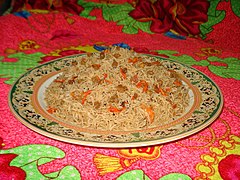Cookbook:Cuisine of Afghanistan
Influences
[edit | edit source]Afghanistan's culinary specialties reflect its ethnic and geographic diversity and has similarities with neighboring Iran, India, Tajikistan, Uzbekistan, Turkmenistan, and Pakistan.
Kabul influence
[edit | edit source]Kabul, the capital of Afghanistan, is a multi-ethnic city and has always been so. As the seat of government for the Pashtun Afghan kings, food was an important part of royal life. Chefs were commissioned from all over the empire and places afar. They are credited for creating a myriad of dishes, blending different styles and in the process creating the best examples of true Afghan cooking. Their creations include exotic kormas, palaos, sumptious rice dishes, desserts, and other creative items. These royal chefs passed down their art to aristocrat denizens of Kabul, they in turn to others. Several attempts were made to record the arts of the royal chefs. Two such publications have been published. The first one, published in Afghanistan in the early 1900s, recorded the ingredients and cooking styles of Afghanistan's monarchy. The second, called Aushpazi, by Wali Zikria, published in the United States in English, during the early 1990s, was essentially the cookbook of one of Afghanistan's royal houses.
Characteristics
[edit | edit source]Afghan food is largely based upon the nation's chief crops: cereals like wheat, maize, barley, and rice. Accompanying these staples are dairy products (yogurt, whey), various nuts, and native vegetables, and fresh and dried fruits; Afghanistan is well known for its grapes. Various pickled fruits and vegetables (torshi) such as peaches, and eggplant are served. Pepper sauces called chatney are usually made with vinegar, fresh cilantro, chili peppers, and sometimes tomato paste.
Breads
[edit | edit source]
There are three main types of Afghan bread:
- Naan: Literally "bread"; thin, long, and oval shaped; mainly a white/whole wheat blend, topped with poppy seeds, sesame seeds, nigella seeds, or some combination of these. Upon request, customers may be able to get all-white flour and a helping of oil, which makes it rich and delicious.
- Obi non: an Uzbek-style bread, shaped like a disc and thicker than naan; usually made with white flour
- Lavash: a very thin bread, Usually used as plating for meats and stews; similar to the Lavash made elsewhere.
Dumplings
[edit | edit source]Afghan cuisine features dumplings, notably the meat and onion-filled mantu and the gandana/leek-filled ashak. Both are commonly topped with yogurt-based sauces.
Sweets
[edit | edit source]Sweet foods include sheer pira (a type of milk confection), a variety of fried pastries, and fudge-like halwa.
Common ingredients
[edit | edit source]Meat
[edit | edit source]Lamb and mutton are very common and tend to be marinated.
Fruits and vegetables
[edit | edit source]A variety of fruits and vegetables are used, such as onion, tomato, pomegranates, grapes, melons, okra, and squash. Nuts and dried fruits are also very common.
Grains and legumes
[edit | edit source]Wheat, maize, and rice are the major grain crops of the region. Legumes include lentils.
Seasonings
[edit | edit source]Afghan cuisine features a variety of seasonings, including coriander, mint, garlic, cumin, cinnamon, sesame, cardamom, saffron, and rosewater.
Dairy
[edit | edit source]Yogurt features prominently in Afghan cuisine, where is used to accompany a variety of dishes.
Customs
[edit | edit source]In Afghan culture, the custom is to eat with the hands, scooping up food with bread. The right hand is usually used.
Table spread
[edit | edit source]
Known as the destarkhan or sofrah, the table spread is an important expression of culture in Afghanistan. Regardless of economic status, creating an adequate destarkhan is important to any family, especially when having guests over. A large cloth will most likely be spread over a traditional rug in the living area or on a formal dining table. Most likely a young member of the family will present a "aftabah wa lagan", a copper basin and elaborate pot filled with water for the household to wash their hands in. They will go around the destarkhan to each member, and pour water over their hands. Soap is provided, as is a drying cloth. The destarkhan is then dutifully filled with breads, accompaniments, relishes, appetizers, main courses, salads, rice, and fruits. Arrangement of foods is important when having guests; they must have easy access to the specialty foods. Young children are taught how to spread a good destarkhan and will be busy helping their parents.
Gallery
[edit | edit source]-
Bolani (a stuffed flatbread) with condiments
-
Ashak dumplings topped with a meat sauce
-
Mantu topped with yogurt sauce
-
Pulao
-
Afghan naan
-
Stewed okra
Recipes
[edit | edit source]External links
[edit | edit source]- https://www.worldtravelguide.net/guides/asia/afghanistan/food-and-drink/
- https://www.foodrepublic.com/2012/07/31/everything-you-need-to-know-about-afghan-food/
- https://www.sbs.com.au/food/article/2013/02/14/about-afghan-food
- https://www.npr.org/2006/12/06/6578725/discovering-afghan-cuisine-a-world-away?t=1638190398382






